Since the discovery some thirty years ago that nucleons and mesons, or more generally hadrons, are made of quarks, we have been wondering why quarks only come in doublets or triplets. 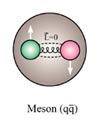
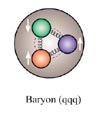 Heavy hadrons, or baryons, consist of three quarks; mesons are made of a quark-antiquark pair. The theory of strong interaction, Quantum Chromo Dynamics (QCD), allows for different quark combinations provided they are colour neutral. The observation of such exotic hadrons promises insight into the largely unknown dynamics of quark-gluon systems, in particular with respect to the confinement of quarks within hadrons.
Heavy hadrons, or baryons, consist of three quarks; mesons are made of a quark-antiquark pair. The theory of strong interaction, Quantum Chromo Dynamics (QCD), allows for different quark combinations provided they are colour neutral. The observation of such exotic hadrons promises insight into the largely unknown dynamics of quark-gluon systems, in particular with respect to the confinement of quarks within hadrons.
Pentaquarks
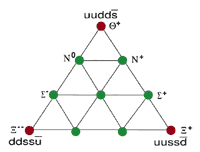 There has been much excitement recently about the first evidence for the existence of baryons consisting of five quarks, pentaquarks, found in about a dozen experiments around the world. Exotic pentaquarks populate the corners of the baryon anti-decuplet shown to the right and cannot be made of three quarks only. The Glasgow-Edinburgh team participated in three of the experiments at CLAS and HERMES which reported evidence for the
There has been much excitement recently about the first evidence for the existence of baryons consisting of five quarks, pentaquarks, found in about a dozen experiments around the world. Exotic pentaquarks populate the corners of the baryon anti-decuplet shown to the right and cannot be made of three quarks only. The Glasgow-Edinburgh team participated in three of the experiments at CLAS and HERMES which reported evidence for the![]() in 2004. Since then, we have performed two further high-statistics experiments for different reaction channels at CLAS, where the
in 2004. Since then, we have performed two further high-statistics experiments for different reaction channels at CLAS, where the![]() does not show up. Further experiments are planned.
does not show up. Further experiments are planned.
Exotic Hybrid Mesons
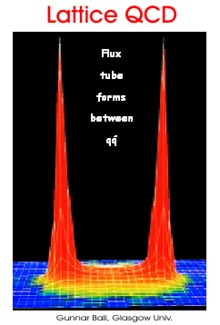 The strong interaction between quarks is mediated by the exchange of gluons. In contrast to photons (electrodynamic interactions), gluons carry charge. They interact with one another forming flux tubes, as depicted in the left hand figure. The interaction potential increases linearly with inter-quark distance giving rise to confinement. We expect to obtain information on the mechanism of confinement by studying the excitation spectrum of the "string" of gluons between the quark-antiquark pair. Experimentally, this is equivalent to searching for exotic hybrid mesons consisting of a quark-antiquark-gluon triplet (see right hand figure) with quantum numbers that cannot be created by a quark-antiquark pair. Such experiments are being carried out by the GlueX Collaboration for the light "up" and "down" quark
The strong interaction between quarks is mediated by the exchange of gluons. In contrast to photons (electrodynamic interactions), gluons carry charge. They interact with one another forming flux tubes, as depicted in the left hand figure. The interaction potential increases linearly with inter-quark distance giving rise to confinement. We expect to obtain information on the mechanism of confinement by studying the excitation spectrum of the "string" of gluons between the quark-antiquark pair. Experimentally, this is equivalent to searching for exotic hybrid mesons consisting of a quark-antiquark-gluon triplet (see right hand figure) with quantum numbers that cannot be created by a quark-antiquark pair. Such experiments are being carried out by the GlueX Collaboration for the light "up" and "down" quark 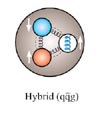 sector at the upgraded CEBAF electron accelerator in Jefferson Lab, USA, and by the PANDA Collaboration for the heavier "charmed" quark sector at the new Facility for Antiproton and Ion Research, FAIR, in Germany (cf. SUPA Initiative "Hadrons in Nuclear Physics" for more details).
sector at the upgraded CEBAF electron accelerator in Jefferson Lab, USA, and by the PANDA Collaboration for the heavier "charmed" quark sector at the new Facility for Antiproton and Ion Research, FAIR, in Germany (cf. SUPA Initiative "Hadrons in Nuclear Physics" for more details).
Glueballs
Lattice QCD predicts the existence of particles which consist purely of energy, so-called glueballs. An extensive search for these wild QCD animals was performed at the 2 GeV antiproton storage ring LEAR at CERN a decade ago with 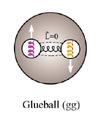 inconclusive results. At this low incident antiproton energy only light glueballs can be produced which mix strongly with ordinary mesons. The new accelerators at FAIR deliver a 15 GeV antiproton beam with which heavy glueballs in the sparsely populated charmed meson region can be produced at PANDA (cf. SUPA Initiative "Hadrons in Nuclear Physics" for more details).
inconclusive results. At this low incident antiproton energy only light glueballs can be produced which mix strongly with ordinary mesons. The new accelerators at FAIR deliver a 15 GeV antiproton beam with which heavy glueballs in the sparsely populated charmed meson region can be produced at PANDA (cf. SUPA Initiative "Hadrons in Nuclear Physics" for more details).
